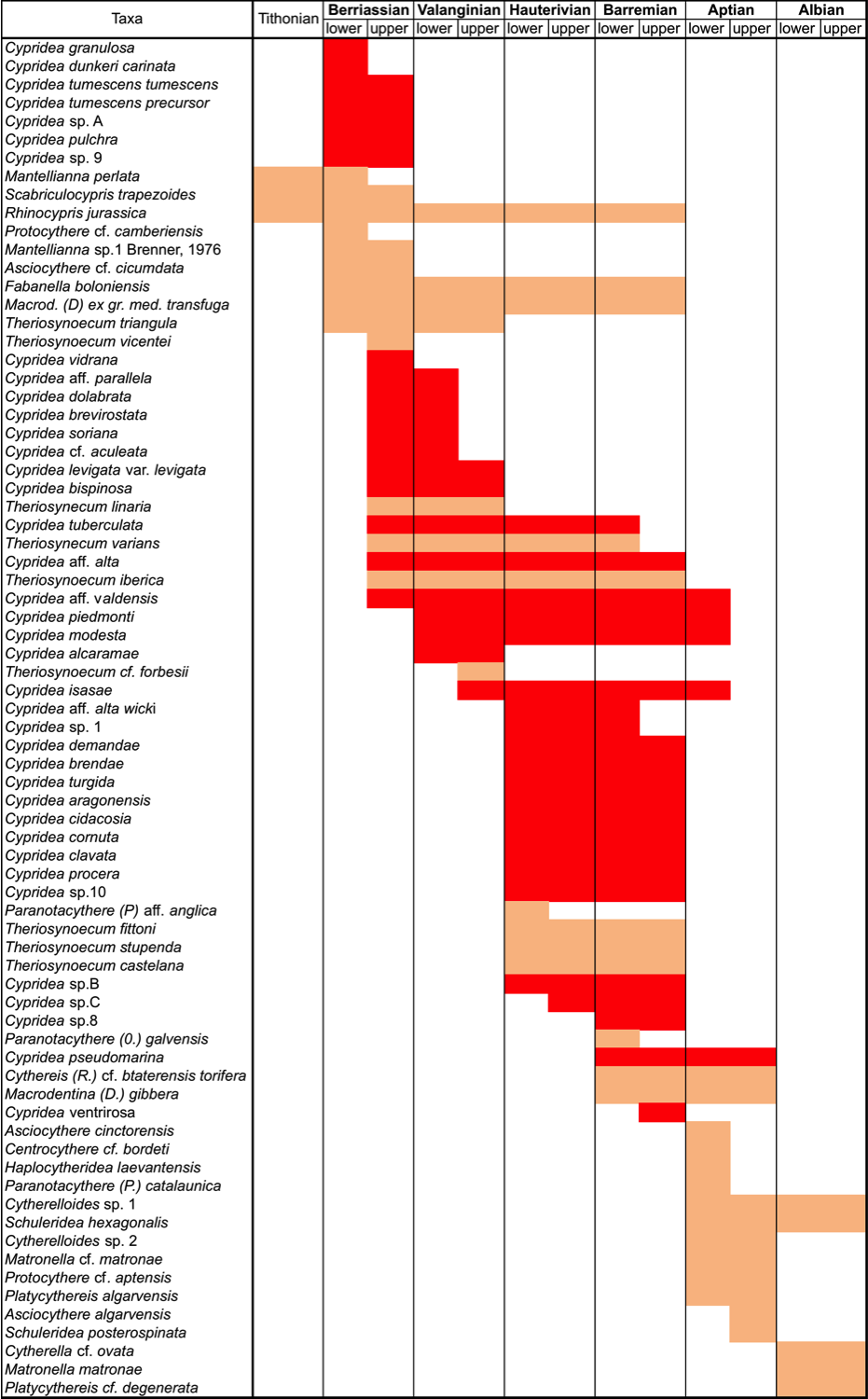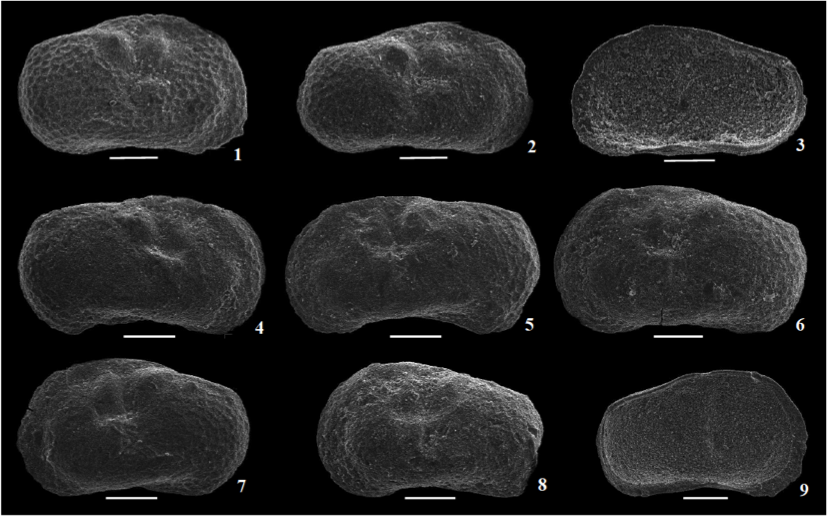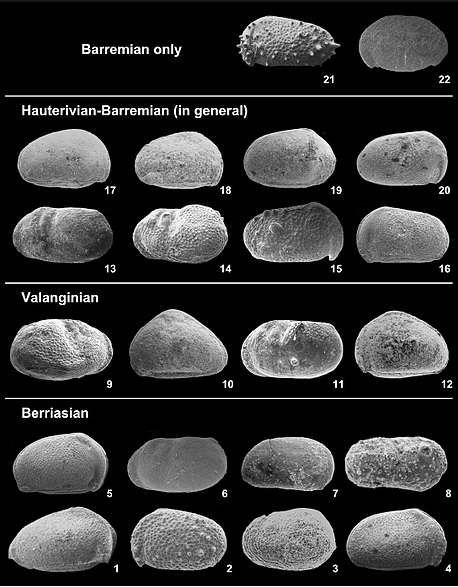Ostracod BIOSTRATIGRAPHY
Semi-quantitatives analyses, from Mesozoic to Cenozoic, everywhere in the world.
High-quality biostratigraphic and paleoenvironments interpretations.
Interpretation of recorded species is based on the global and/or regional biostratigraphic charts.
BIOSTRATGRAPHY CHART
Cretaceous, Europe
Early Cretaceous ostracod biostratigraphy of the Iberian chain (eastern Spain )

The most frequent freshwater species identified by Schudak & Schudack, (2009) :
1. Cypridea tumescens tumescens, 2. Cypridea tuberculata, 3. Theriosynoecum forbesii. 4. Cypridea tumescens praecursor, 5. Cypridea aff. parallela, 6. Theriosynoecum vincentei, 7. Cypridea laevigata, 8. Rhinocypris jurassica, 9. Theriosynoecum triangula, 10. Cypridea brevirostrata, 11. Theriosynoecum linaria, 12. Cypridea bispinosa, 13. Theriosynoecum iberica, 14. Theriosynoecum fittoni, 15. Cypridea clavata, 16. Cypridea isasae, 17. Cypridea demandae, 18. Cypridea aff. valdensis, 19. Cypridea piedmonti, 20. Cypridea modesta, 21. Cypridea pseudomarina, 22. Cypridea ventriosa.
Reference
Schudack U.& Schudack, M., 2009. Ostracod biostratigraphy on the Lower Cretaceous of the Iberian chain (eastern Spain). Journal of Iberian Geology 35 (2) 2009: 141 – 168.
CASE STUDY
China
Ostracod analyses and biostratigraphic interpretation for studied sample

Ostracod, genus Scordisciasp. from sample WK-17 (RV, right valve; LV, left valve):
1, Scordiscia sp., RV female, external lateral view; 2, Scordiscia sp., RV female, external lateral view; 3, Scordiscia sp., RV female, internal lateral view; 4, Scordiscia sp., RV male, external lateral view; 5, Scordisciasp., LV male, external lateral view; 6, Scordiscia sp., LV female, external lateral view; 7,Scordiscia sp., LV female, external lateral view; 8, Scordiscia sp., LV female, external lateral view ; 9, Scordiscia sp., LV female, internal lateral view.
Fossil content:
Monospecific association of Scordisciasp., 43 valves and 21 carapaces; among the fossils, only 3 juveniles recorded, the others are adult; the females absolutely prevail on males.
Size of the individuals: 0.50 mm.
Taxonomic determination: Scordiscia sp.
The individuals are from the family of Limnocytheridae Klie, 1938. Polygonal pits cover the outer surface, semi-smooth to smooth with two distinctive nodes in dorsal area, one weak node in central area and a ventral ridge showing a “smiley face” pattern (Whittaker and Horne, 2009). These characteristics are typical of Scordiscia Krstič and Schornikov, 1993. The valves have distinct sexual dimorphism male being longer and rectangular. The individuals from studied sample have thin valves and thin hinge, but typical Scordiscia species are well calcified. Scordiscia sp. has shorter and slightly rounded dorsal margin on the LV than Scordiscia marinae (Krstić and Schornikov 1993) from the Pleistocene of the British Islands (Whittaker and Horne, 2009). Scordiscia sp. has larger ventral concavity, dorsal margin largely rounded on the first half of the LV and its ventral ridge is not so pronounced as on Scordiscia jiriceki Krstić, 1993 from Pliocene of Serbia (Krstić, 2006; Krstić et al., 2012). Scordiscia aff. n.sp. Schornikov, 1993 from late Miocene and early Pliocene of Turkey shows a distinctive posterior ridge (Witt 2003). Scordiscia caspiensis (Negadaev-Nikonov, 1957) shows large rounded pits on the surface and the ventral ridge recovers the ventral margin. Scordiscia dorsotuberculata (Negadaev-Nikonov, 1957) has irregular dorsal margin, while Scordiscia sp. has the dorsal margin rounded on the first half and then straight. Both species come from the Quaternary of the Western Siberia (Konovalova, 2012 a, b).
Other species:
Scordiscia grinfeldi (Liepin and Kazmina, 1960) – in Witt, 2003, Scordiscia quadrata (Mandelstam, 1962) – Pliocene-post Pliocene of Turkmenistan in Witt, 2003, Scordiscia baltica (Kazmina, 1975) – Pliocene- early PleistoceneWest Siberian Plain in Witt, 2003., Scordiscia varain Schornikov and Tsareva, 2009.
Stratigraphy and Paleobiogeographic distribution :
Scordiscia is a fossil genus and its oldest fossil record comes probably from the late Miocene of Turkey (Witt, 2003). Its presence is known mainly from the Pliocene and Quaternary deposits of Europe and Asia (Palearctic region).

Age and paleoenvironment interpretation
The studied sample contains only individuals of Scordisciasp. The genus is typical for (littoral) limnic environment and the Pliocene and Pleistocene is the most probable age of the sample.
References
Konovalova V.A., 2012a. Revision of the Quaternary Limnocytheridae Sars, 1925 (Ostracoda) of Western Siberia. Trudy XV Vserossiiskogo mikropaleonotlogicheskogo soveshchania “Sovremennaia mikropaleontologia, Gelendzhik, 231-235. (in Russian)
Konovalova V.A., 2012. New and little known ostracod species of Middle Neopleisotcene and Holocene from south-east of the West Siberian Plain. Paleonotologitchesii Journal, 3, 21-28. (In Russian)
Krstić N., 2006. Pliocene Ostracodes of the Paludinian Beds in the Pannonian Plain, Serbian Part. Glasnik Prirodnjackog muzeja, XIII, 1-409.
Krstić N., Savić L., Jovanović G., 2012. The Neogene Lakes on the Balkan Land. Annales Géologiques de la Péninsule Balkanique, 73, 37-60.
Meisch C., 2000. Freshwater Ostracoda of Western and Central Europe. Spektrum Akademischer Verlag, Heidelberg – Berlin, pp. 1-522.
Schornikov E.I., Tsareva O.A., 2009. Holotypes of ostracods of Order Podocopida from the collection of the Museum of A.V.Zhirmunsky Institute of Marine Biology FEB RAS (Vladivostok). Zootaxa 2071, 21–34.
Witt W., 2003. Freshwater Ostracods from Neogene deposits of Develiköy (Manisa, Turkey). Zitteliana, A43, 93-108.
Whittaker J.E., Horne D.J. 2009. Pleistocene. In: J. E. Whittaker, M. B. Hart (eds.): Ostracods in British Stratigraphy. Geological Society Publishing House, 447-467.
Zhai D., Xiao J., Fan J., Wen R., Pang Q., 2015. Differential transport and preservation of the instars of Limnocythere inopinata (Crustacea, Ostracoda) in three large brackish lakes in northern China. Hydrobiologia, 747, 1-18.
